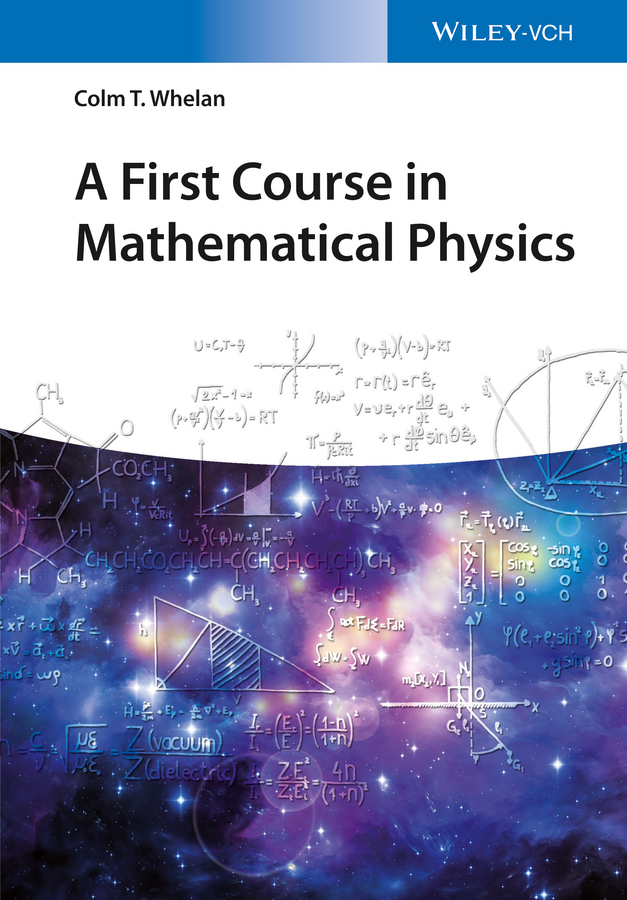
The book assumes next to no prior knowledge of the topic. The first part introduces the core mathematics, always in conjunction with the physical context. In the second part of the book, a series of examples showcases some of the more conceptually advanced areas of physics, the presentation of which draws on the developments in the first part. A large number of problems help students to hone their skills in using the presented mathematical methods. Solutions to the problems are available to instructors on an associated password–protected website for lecturers. INDICE: Preface page ix. . Part I: Mathematics 1. . 1 Functions of one variable 2. 1.1 Limits 2. 1.2 Elementary Calculus 6. 1.2.1 Chain Rule 7. 1.2.2 Differentiation products and quotients 8. 1.2.3 Inverse Functions 9. 1.3 Integration 10. 1.4 The Binomial Expansion 13. 1.5 Taylor?s series 15. 1.6 Extrema 17. 1.7 Power Series 18. 1.8 Basic Functions 19. 1.8.1 Exponential 19. 1.8.2 Logarithm 23. 1.9 1st order ordinary differential equations 24. 1.10 Trigonometric Functions 26. 1.10.1 L?Hopital?s rule 28. 1.11 Problems 30. . 2 Complex numbers 33. 2.1 Exponential function of a complex variable 34. 2.2 Argrand Diagrams and the Complex Plane 36. 2.3 Hyperbolic functions 38. 2.4 The simple harmonic oscillator 40. 2.4.1 Mechanics in one dimension 42. 2.5 Problems 45. . 3 Functions of Several Variables 48. 3.1 Partial derivatives 48. 3.1.1 Definition of the partial derivative 48. 3.1.2 Total derivatives 51. 3.1.3 Some relations 53. 3.1.4 Change of variables 55. 3.1.5 Mechanics again 56. 3.1.6 Exact differentials and thermodynamics 58. 3.2 Extrema under constraint 60. 3.3 Multiple Integrals 62. 3.3.1 Triple Integrals 66. 3.3.2 Change of variables 67. 3.4 Problems 69. . 4 Vectors in R3 72. 4.1 Basic operation 72. 4.1.1 scalar triple product 79. 4.1.2 Vector equations of lines and planes 80. 4.2 Kinematics in three dimensions 81. 4.2.1 Differentiation 81. 4.2.2 Motion in a uniform magnetic field 81. 4.3 Coordinate systems 83. 4.3.1 Polar coordinates 83. 4.4 Central Forces 84. 4.5 Rotating Frames 88. 4.5.1 Larmor Effect 91. 4.6 Problems 93. . 5 Vector fields and operators 96. 5.1 The gradient operator 96. 5.1.1 Coordinate Systems 97. 5.2 Work and energy in vectorial mechanics 101. 5.2.1 Line integrals 104. 5.3 A little fluid dynamics 107. 5.3.1 Rotational motion 111. 5.3.2 Fields 114. 5.3.3 Surface integrals 115. 5.4 The divergence theorem 118. 5.5 Stokes? Theorem 121. 5.5.1 Conservative Forces 123. 5.6 Problems 126. . 6 Generalized Functions. 130. 6.1 The Dirac delta function 130. 6.2 Problems 139. . 7 Vector Spaces 140. 7.1 Formal Definition of a vector space 140. 7.2 Fourier Series 145. 7.3 Linear Operators 148. 7.4 Change of basis 160. 7.5 Problems 163. . Part II: Physics 168. . 8 Maxwell?s Equations: A very short Introduction 169. 8.1 Electrostatic: Gauss?s Law 169. 8.2 Gauss?s Law for a magnetic field 173. 8.3 Ampere?s Law 173. 8.3.1 Gauge conditions 174. 8.4 Problems 177. . 9 Special Relativity:4–vector formalism 179. 9.1 Lorentz transformation 179. 9.1.1 Inertial frames 179. 9.1.2 Properties and consequences of the Lorentz transformation. 182. 9.2 Minkowski space 183. 9.2.1 Four vectors 183. 9.2.2 Time Dilation 189. 9.3 Four velocity 190. 9.3.1 Four momentum 191. 9.4 Electrodynamics 197. 9.4.1 Maxwell?s equations in 4–vector form 197. 9.4.2 Field of a moving point charge 200. 9.5 Problems 202. . 10 Quantum Theory 205. 10.1 Formalism 205. 10.1.1 Dirac notation 206. 10.2 Probabilistic interpretation 207. 10.2.1 Commutator relations 208. 10.2.2 Functions of observables 210. 10.3 The Stern–Gerlach experiment 210. 10.3.1 Spin space 210. viii Contents. 10.3.2 Explicit matrix representation 210. 10.3.3 EPR paradox 210. 10.3.4 Bell?s Theorem 210. 10.4 Quantization 210. 10.4.1 Time evolution 210. 10.4.2 The harmonic oscillator, coherent states 210. 10.5 Problems 212. . 11 Atoms, molecules, solids, wave mechanics in one dimension. 216. 11.1 Atom 217. 11.1.1 The square well 218. 11.1.2 The delta function potential 219. 11.2 Molecules 221. 11.3 Solids 223. 11.3.1 Block?s Theorem 224. 11.3.2 Band structure 226. 12 An informal treatment of variational principles and their. history 229. . Appendix 1 Conic Sections 230. Appendix 2 Vector Relations 232. Index 237.
- ISBN: 978-3-527-41333-1
- Editorial: Wiley VCH
- Encuadernacion: Rústica
- Páginas: 260
- Fecha Publicación: 13/01/2016
- Nº Volúmenes: 1
- Idioma: Inglés
